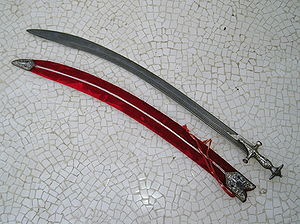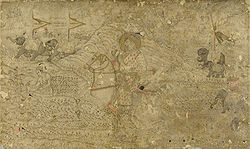
Talwar
Encyclopedia
The talwar is a type of curved sword or sabre
from India
and modern-day Pakistan
. The word is also spelled talwaar and tulwar.
, the Turkish kilij
and the Afghan pulwar
, all such swords being originally derived from earlier curved swords developed in Turkic Central Asia..
The use of talwar became more widespread under the Islamic Mughal
Dynasty who were of Turco-Mongol origins. The Mughal Emperor Akbar is known to have built large foundries producing the best quality sword blades; Akbar himself is known to have preferred Damascus steel
Talwars, which were considered the sharpest blades ever used in battle in South Asia
.
The blade profile of the British Pattern 1796 light cavalry sabre
is similar to some examples of the Mysore Talwar utilized by the forces of Tipu Sultan
, and expert opinion has suggested that the talwar, due to its effectiveness and successful use in battle in the Indian subcontinent, may have contributed to the design of the British sabre.
 Though strongly influenced by Middle Eastern swords, the typical talwar has a wider blade than the shamshir
Though strongly influenced by Middle Eastern swords, the typical talwar has a wider blade than the shamshir
, and lacks the expanded yelman (false-edge) of the kilij. Late examples often had European-made blades, set into distinctive Indian-made hilts. The hilt of the typical talwar is termed a "disc hilt" from the prominent disc-shaped flange surrounding the pommel
. The pommel often has a short spike projecting from its centre, sometimes pierced for a cord to secure the sword to the wrist. The hilt incorporates a simple cross-guard which frequently has a slender knucklebow attached. The hilt is usually entirely of iron, though brass and silver hilts are found, and is connected to the tang of the blade by a very powerful adhesive resin. More ornate examples of the talwar often show silver or gilt decoration in a form called koftigari.
 The talwar was used by both cavalry and infantry. The grip of the talwar is cramped and the prominent disc of the pommel presses into the wrist if attempts are made to use it to cut like a conventional sabre. These features of the talwar hilt result in the hand having a very secure and rather inflexible hold on the weapon, enforcing the use of variations on the very effective "draw cut". The fact that the talwar does not have the kind of radical curve of the shamshir indicates that it could be used for thrusting as well as cutting purposes. Unlike some similar blades which have a very radical curve at the lower half of the blade - which make them very good slashing weapons but limit their use as a thrusting or cutting blades - the talwar can be used effectively for all three purposes either by mounted warrior or by foot soldier. The blades of some examples of the Talwar widen towards the tip. This increases the momentum of the distal portion of the blade when used to cut; when a blow was struck by a skilled warrior limbs could be amputated and persons decapitated. The spike attached to the pommel could be used for striking the opponent in extreme close quarter circumstances when it was not always possible to use the blade. The talwar is held with fore finger wrapping around the lower cross guard. This weapon is still used for talwar zani or matam e talwar, (Arabic: tatbir) Shiite Muslim self-flagellation, on 10th of Muharram, marking the martydom of Imam Hussain. Today, the word talwar literally means sword or dagger in the majority of languages spoken in the Indian subcontinent.
The talwar was used by both cavalry and infantry. The grip of the talwar is cramped and the prominent disc of the pommel presses into the wrist if attempts are made to use it to cut like a conventional sabre. These features of the talwar hilt result in the hand having a very secure and rather inflexible hold on the weapon, enforcing the use of variations on the very effective "draw cut". The fact that the talwar does not have the kind of radical curve of the shamshir indicates that it could be used for thrusting as well as cutting purposes. Unlike some similar blades which have a very radical curve at the lower half of the blade - which make them very good slashing weapons but limit their use as a thrusting or cutting blades - the talwar can be used effectively for all three purposes either by mounted warrior or by foot soldier. The blades of some examples of the Talwar widen towards the tip. This increases the momentum of the distal portion of the blade when used to cut; when a blow was struck by a skilled warrior limbs could be amputated and persons decapitated. The spike attached to the pommel could be used for striking the opponent in extreme close quarter circumstances when it was not always possible to use the blade. The talwar is held with fore finger wrapping around the lower cross guard. This weapon is still used for talwar zani or matam e talwar, (Arabic: tatbir) Shiite Muslim self-flagellation, on 10th of Muharram, marking the martydom of Imam Hussain. Today, the word talwar literally means sword or dagger in the majority of languages spoken in the Indian subcontinent.
Sabre
The sabre or saber is a kind of backsword that usually has a curved, single-edged blade and a rather large hand guard, covering the knuckles of the hand as well as the thumb and forefinger...
from India
India
India , officially the Republic of India , is a country in South Asia. It is the seventh-largest country by geographical area, the second-most populous country with over 1.2 billion people, and the most populous democracy in the world...
and modern-day Pakistan
Pakistan
Pakistan , officially the Islamic Republic of Pakistan is a sovereign state in South Asia. It has a coastline along the Arabian Sea and the Gulf of Oman in the south and is bordered by Afghanistan and Iran in the west, India in the east and China in the far northeast. In the north, Tajikistan...
. The word is also spelled talwaar and tulwar.
History
The talwar originated alongside other curved Middle Eastern swords such as the Arab saif, the Persian shamshirShamshir
A Shamshir also Shamsheer and Chimchir, is a type of sabre with a curve that is considered radical for a sword: 5 to 15 degrees from tip to tip. The name is derived from Persian شمشیر shamshīr, which means "sword"...
, the Turkish kilij
Kilij
A kilij is a type of saber used by the Turks throughout history starting from late Hsiung-nu period to Avar Empire and Göktürk Khaganate, Uyghur Khaganate, Seljuk Empire, Timurid Empire, Mamluk Empire, Ottoman Empire, and later Turkic Khanates of Central Asia...
and the Afghan pulwar
Pulwar
A pulwar is a single handed curved sword from Afghanistan and neighbouring regions of Pakistan and Northwestern India.-Characteristics:...
, all such swords being originally derived from earlier curved swords developed in Turkic Central Asia..
The use of talwar became more widespread under the Islamic Mughal
Mughal Empire
The Mughal Empire , or Mogul Empire in traditional English usage, was an imperial power from the Indian Subcontinent. The Mughal emperors were descendants of the Timurids...
Dynasty who were of Turco-Mongol origins. The Mughal Emperor Akbar is known to have built large foundries producing the best quality sword blades; Akbar himself is known to have preferred Damascus steel
Damascus steel
Damascus steel was a term used by several Western cultures from the Medieval period onward to describe a type of steel used in swordmaking from about 300 BCE to 1700 CE. These swords are characterized by distinctive patterns of banding and mottling reminiscent of flowing water...
Talwars, which were considered the sharpest blades ever used in battle in South Asia
South Asia
South Asia, also known as Southern Asia, is the southern region of the Asian continent, which comprises the sub-Himalayan countries and, for some authorities , also includes the adjoining countries to the west and the east...
.
The blade profile of the British Pattern 1796 light cavalry sabre
Pattern 1796 light cavalry sabre
The Pattern 1796 Light Cavalry Sabre, is a sword that was used primarily by British Light Dragoons and hussars, and King's German Legion light cavalry during the Napoleonic Wars...
is similar to some examples of the Mysore Talwar utilized by the forces of Tipu Sultan
Tipu Sultan
Tipu Sultan , also known as the Tiger of Mysore, was the de facto ruler of the Kingdom of Mysore. He was the son of Hyder Ali, at that time an officer in the Mysorean army, and his second wife, Fatima or Fakhr-un-Nissa...
, and expert opinion has suggested that the talwar, due to its effectiveness and successful use in battle in the Indian subcontinent, may have contributed to the design of the British sabre.
Characteristics

Shamshir
A Shamshir also Shamsheer and Chimchir, is a type of sabre with a curve that is considered radical for a sword: 5 to 15 degrees from tip to tip. The name is derived from Persian شمشیر shamshīr, which means "sword"...
, and lacks the expanded yelman (false-edge) of the kilij. Late examples often had European-made blades, set into distinctive Indian-made hilts. The hilt of the typical talwar is termed a "disc hilt" from the prominent disc-shaped flange surrounding the pommel
Pommel
Pommel may refer to:* pommel, the raised area at the front of an equestrian saddle.* Pommel, the counterweight at the end of the hilt of a European sword* Pommel horse, an artistic gymnastics apparatus...
. The pommel often has a short spike projecting from its centre, sometimes pierced for a cord to secure the sword to the wrist. The hilt incorporates a simple cross-guard which frequently has a slender knucklebow attached. The hilt is usually entirely of iron, though brass and silver hilts are found, and is connected to the tang of the blade by a very powerful adhesive resin. More ornate examples of the talwar often show silver or gilt decoration in a form called koftigari.
Use

See also
- Mughal weaponsMughal WeaponsMughal Weapons, The Military of the Mughal Empire used a variety of weapons in their conquests throughout the centuries. various types of: swords, bow & arrows, horses, camels, elephants, various types of cannons , muskets and Flintlock Blunderbuss...
- FirangiFirangi (sword)The firangi derived from the Arabic term for a Western European [a "Frank"]) was an Indian sword type which used blades manufactured in Western Europe and imported by the Portuguese, or made locally in imitation of European blades.-Physical characteristics:...
- SabreSabreThe sabre or saber is a kind of backsword that usually has a curved, single-edged blade and a rather large hand guard, covering the knuckles of the hand as well as the thumb and forefinger...
- PulwarPulwarA pulwar is a single handed curved sword from Afghanistan and neighbouring regions of Pakistan and Northwestern India.-Characteristics:...
- ShamshirShamshirA Shamshir also Shamsheer and Chimchir, is a type of sabre with a curve that is considered radical for a sword: 5 to 15 degrees from tip to tip. The name is derived from Persian شمشیر shamshīr, which means "sword"...
- KilijKilijA kilij is a type of saber used by the Turks throughout history starting from late Hsiung-nu period to Avar Empire and Göktürk Khaganate, Uyghur Khaganate, Seljuk Empire, Timurid Empire, Mamluk Empire, Ottoman Empire, and later Turkic Khanates of Central Asia...
- Saif
- ZulfiqarZulfiqarZulfiqar "bifurcated" is the sword of the Islamic leader Ali. In Arabic the name is commonly transliterated as Dhu al-Fiqar, Thulfeqar, Dhulfiqar, Zoulfikar etc. The name Zulfiqar means which divides exactly in two parts....
- KhanjarKhanjarThe khanjar is the traditional dagger of Oman. It is similar to the Yemeni jambiya.The khanjar is curved and sharpened on both edges...
- Tatbir

